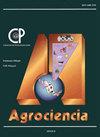FORAGE YIELD AND COMPOSITION OF Avena strigosa Schreb AT DIFFERENT HARVESTING FREQUENCIES AND INTENSITIES
IF 0.5
4区 农林科学
Q4 AGRICULTURE, MULTIDISCIPLINARY
引用次数: 0
Abstract
Harvesting frequency and intensity are management criteria in forage plants and their choices affect herbage yield and quality. The objectives of the study were to evaluate herbage yields of morphological components and chemical composition (crude protein, neutral detergent fiber and acid detergent fiber) of Saia oats (Avena strigosa Schreb) at three harvest frequencies (40, 50 and 60 cm sward height) and three harvest intensities (8, 14 and 20 cm residual foliage). The design was completely randomized with a factorial arrangement (3 × 3) of treatments and four replications. The factors were sward height (AD) and harvest intensity (IC). The experimental units were 36 plots of 12 m2. Forage yield increased linearly (p = 0.007) with the increase in sward height (35 kg DM cm-1, R2 = 0.91). Leaf blade yield decreased (-33 kg DM cm-1, R2 = 0.99, p = 0.001) and pseudo stem plus stem yield increased (46 kg DM cm-1, R2 = 0.98, p = 0.001) with increasing sward height. Harvest intensity did not affect foliage yield (p > 0.05); however, leaf blade yield was higher at high harvest intensity (8 cm residual herbage, p < 0.05). Crude protein (CP) showed linear decrease (p = 0.001) as sward height increased (-0.22 % cm-1, R2 = 0.99), and neutral detergent fibre (NDF) was higher (51.2 %) at 60-14 and lower (41.9 %) at 40-8. Forage with higher proportion of leaf blades and lower NDF content was harvested at 40 cm sward height, in combination with moderate harvest intensities (8 and 14 cm residual foliage height).不同收获频率和收获强度下糙皮草料产量及组成
收获频率和强度是饲草植物的管理标准,其选择直接影响牧草的产量和品质。本研究旨在评价三种收获频率(40、50和60 cm草高)和三种收获强度(8、14和20 cm残叶)下野燕麦(Avena strigosa Schreb)形态成分和化学成分(粗蛋白质、中性洗涤纤维和酸性洗涤纤维)的产量。设计完全随机化,采用因子排列(3 × 3)处理和4个重复。影响因子为草高(AD)和收获强度(IC)。试验单元为36块,每块12平方米。牧草产量随草高(35 kg DM cm-1)的增加呈线性增加(p = 0.007, R2 = 0.91)。随着叶片高度的增加,叶片产量降低(-33 kg DM cm-1, R2 = 0.99, p = 0.001),假茎加茎产量增加(46 kg DM cm-1, R2 = 0.98, p = 0.001)。收获强度对叶片产量无显著影响(p > 0.05);收获强度高时叶片产量较高(残余牧草8 cm, p < 0.05)。粗蛋白质(CP)随草高的增加呈线性降低(p = 0.001) (- 0.22% cm-1, R2 = 0.99),中性洗涤纤维(NDF)在60-14时升高(51.2%),在40-8时降低(41.9%)。叶片比例较高、NDF含量较低的牧草在40 cm叶高下收获,并结合中等收获强度(残叶高8和14 cm)。
本文章由计算机程序翻译,如有差异,请以英文原文为准。
求助全文
约1分钟内获得全文
求助全文
来源期刊

Agrociencia
农林科学-农业综合
CiteScore
0.50
自引率
33.30%
发文量
51
审稿时长
18-36 weeks
期刊介绍:
AGROCIENCIA is a scientific journal created and sponsored by the Colegio de Postgraduados. Its main objective is the publication and diffusion of agricultural, animal and forestry sciences research results from mexican and foreign scientists. All contributions are peer reviewed. Starting in the year 2000, AGROCIENCIA became a bimonthly and fully bilingual journal (Spanish and English versions in the same issue). Since 2007 appears every month and a half (eight issues per year). In addition to the printed issues, the full content is available in electronic format.
 求助内容:
求助内容: 应助结果提醒方式:
应助结果提醒方式:


